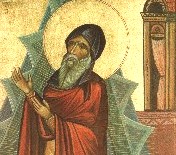The Baptism of Tears: The Two Baptisms of St. Symeon the New Theologian
 One of the distinctives of the contemporary Pentecostal movement has been the understanding that there are two distinct baptisms. Many outside of the movement do not realize that this is not original, though. Beyond the biblical support for this understanding, one can find different personalities and movements throughout the recorded history of the church who attest to the same realization, not the least of which is St. Symeon the New Theologian of the late 10th and early 11th centuries. St. Symeon the New Theologian is one of three individuals honored with the title “theologian” by the Eastern Church: St. John the Evangelist, St. Gregory of Nazianzus and St. Symeon. This in itself shows the high regard that this tradition has for his theological insight. Symeon was a theologian unlike most others, though. His interest was not in discussions concerning the nature of God, rather his concern was in how an individual may come to know God.
One of the distinctives of the contemporary Pentecostal movement has been the understanding that there are two distinct baptisms. Many outside of the movement do not realize that this is not original, though. Beyond the biblical support for this understanding, one can find different personalities and movements throughout the recorded history of the church who attest to the same realization, not the least of which is St. Symeon the New Theologian of the late 10th and early 11th centuries. St. Symeon the New Theologian is one of three individuals honored with the title “theologian” by the Eastern Church: St. John the Evangelist, St. Gregory of Nazianzus and St. Symeon. This in itself shows the high regard that this tradition has for his theological insight. Symeon was a theologian unlike most others, though. His interest was not in discussions concerning the nature of God, rather his concern was in how an individual may come to know God.
It is from the Eastern tradition of which Symeon is a part that we are given the foundational, theological concept of theosis. Theosis is the deification of an individual Christian by the grace of God.1 Deification, also known as divination, is the process by which humanity becomes assimilated, or united with God. This occurs through the energies of God by which God communicates. Deification is understood as a five stage process. The first stage was the deification of human nature that occurred in the Incarnation. As it is based upon the Incarnation, it is concurrently based upon the salvific work of the Christ who was incarnated. It is this salvific work which is the provision of the means for our divination and is the second stage in the process. Deification is, in fact, part of that redemptive work. It is in essence the recapitulation of humanity; that is, it provides for a new ontological reality of humanity.2 It is the τελοσ and culmination of salvation. The third stage is in the initial salvation of the believer which is understood as coming at baptism. The deification of the individual commences in principle at this point. The fourth stage is the process of growth that occurs in the individual believer’s life, the process of emptying of the self and becoming in union with God. This stage is not unlike the concept of Christian perfection as found in Wesleyan thought. The final and full deification of the believer occurs in the reception of the individual into heaven, the beatific vision. For Symeon, deification is the highest possibility for humanity, for it is becoming a god by adoption, not that the creature becomes Creator, but the creature is allowed to share in the divine nature through the grace of God.
What can St. Symeon the New Theologian say to the church today?
In the Eastern tradition it is generally understood that the baptismal rite of initiation is integrally tied to Pentecost. This is in contrast to the Western tradition which places more emphasis on Easter. This process of water bath and anointing signifies the descending of the Spirit upon the baptized. “As He descended upon the disciples in tongues of fire, so the Holy Spirit descends invisibly upon the newly-baptized in the sacrament of the holy chrism.”3 This integrity of the rite is based partially on the theological understanding that the Holy Spirit is active in both baptism and confirmation. It is understood that this is a re-creative act by the purification and the unification of humanity with Christ. This is the culmination and the commencement of the work of Christ. The Spirit confers the complete work of Christ in redemption and new birth upon the baptized. Yet this is only the beginning for the newly baptized infant, for her life from this point on is to be lived for Christ. Symeon goes on to attribute knowledge of God, predestination of salvation, grafting into the vine of Christ and freedom from the bondage to original sin to the work of baptism. The baptized are sealed by the cross and are adopted into the flock of the Shepherd4 All of these theological metaphors point toward one inescapable fact. For Symeon, baptism is salvific, even for the infant who is unable to consciously embrace that which occurs in baptism.5
Category: In Depth, Spring 2019


